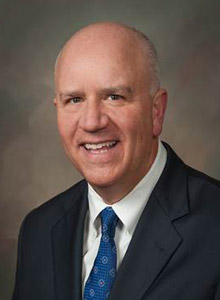Mymobility’s Role in Zimmer Biomet’s Digital Transformation (MedTech Strategist)

On its march to becoming a digital leader in orthopedics, Zimmer Biomet and its partner Apple are bringing enhancements and data to mymobility, their remote monitoring platform. In the current COVID-19 era, that partnership looks prescient.
Zimmer Biomet and Apple Inc.’s decision, announced in October 2018, to create the mymobility digital platform had nothing to do with COVID-19, of course. As the largest player in total joint surgery (TJA), ZBH has been on a determined march toward a future as an orthopedics informatics powerhouse. Given its significant exposure to elective surgery uncertainties, however, any steps the company takes to become more digital-centric reflects responses both to COVID-19 challenges and beyond that, long-term trends in orthopedics.
Mymobility works by connecting potential TJA patients to their healthcare team using an Apple Watch and iPhone. It provides clinicians with important physiological metrics pre-operatively and post-operatively about patients, including heart rate, step count, pain scores, and other functions. Patients are asked to use an app on their phone to communicate their scores and interact with providers.
The program engages patients and monitors their recovery, alerting providers if significant changes occur or milestones are missed. For example, it can track compliance with physical therapy regimens, which has the potential to decrease outpatient physical therapy visits and lower costs.
Further, mymobility has been able to measure some gait features, like step climbing, but that data cannot capture the quality of the step. Now, Zimmer Biomet and Apple are adding gait quality assessment tools to the menu, which can offer additional information, for example, helping to predict when people with joint problems are ready for surgical intervention and compare their progress post-surgery against a database. The new features will be available later this year, Zimmer Biomet says. The concept is similar to mymobility’s approach to measuring heart rate variability, which is a qualitative assessment of health, says Andrew Frieberg, MD, who joined Zimmer Biomet last year as its first chief medical officer—the first person to hold such a position at a leading orthopedics company.
 The new gait measure uses sensors in the Apple Watch and iPhone to passively collect walking speed and double-support time (duration of when both feet are in contact with the ground) when walking on flat surfaces. Patients receive a daily walking goal to capture gait metrics for their surgeon’s review. The readout is a score, which will be paired with alerts that help clinicians and their pre-operative patients assess whether they are near-term candidates for TJA and whether post-op patients are on track to recovery. The Mymobility app is free for patients, but they have to be enrolled in the platform by their providers in order to access its benchmarking and customized care plan features. Zimmer Biomet offers various pricing options to providers to acquire the platform.
The new gait measure uses sensors in the Apple Watch and iPhone to passively collect walking speed and double-support time (duration of when both feet are in contact with the ground) when walking on flat surfaces. Patients receive a daily walking goal to capture gait metrics for their surgeon’s review. The readout is a score, which will be paired with alerts that help clinicians and their pre-operative patients assess whether they are near-term candidates for TJA and whether post-op patients are on track to recovery. The Mymobility app is free for patients, but they have to be enrolled in the platform by their providers in order to access its benchmarking and customized care plan features. Zimmer Biomet offers various pricing options to providers to acquire the platform.
“Most of us think that the future of joint replacement and many recon procedures relates to predictive analytics and personalized care,” says Freiberg, who previously led the hip and knee service line for 20 years at Massachusetts General Hospital. People currently make these critical decisions without context, but mymobility data empowers them to make informed decisions by benchmarking data that reflects the population at large, he continues.
Data is Coming
Since announcing their partnership, the companies have embarked on a three-phase study of mymobility. A pilot study assessing implementation of the platform into orthopedic practice workflow completed in May 2020, with results yet to be announced.
A more far-reaching, randomized controlled trial has a primary endpoint designed to assess if mymobility is cost effective and clinically non-inferior compared to routine care for impact on all-cause 30-day readmission rates. It is expected to be completed in the second quarter 2021, although initial, 90-day outcome data could be submitted for publication later this year. A large, 10,000-patient observational study that evaluates the relationship between Apple HealthKit biometrics and clinical outcomes should have early data ready for publication also later this year.
Secondary endpoints of these studies include, among others, patient reported osteoarthritis outcome scores for joint replacement (KOOS JR), hip injury and osteoarthritis score for joint replacement (HOOS JR), and whether patients who complete the mymobility program use fewer healthcare resources and spend less money than those who receive standard of care.
Mymobility is part of a broader digital transformation of Zimmer Biomet that affects its offerings to all stakeholders. The data it collects on individual patients will be uploaded into the company’s OrthoIntel Orthopedic Intelligence Platform, for example, which aims to provide surgeons and care teams with new clinical insights.
The company’s robotics and navigation innovation center in Montreal is another aspect of its drive to incorporate information technology into its core strategy. Much of the work on Zimmer Biomet’s ROSA total knee robotics system is centered there, with software development occurring in Grand Rapids, MI, and Portland, OR, offices.
Montreal has become a high-tech hub, and a center for the gaming industry, says Frieberg. “We do not separate the robotic offering from other parts of the system—you get the best success for surgeons and patients through integration of technologies and data science. We have incredible depth in software capabilities.”

